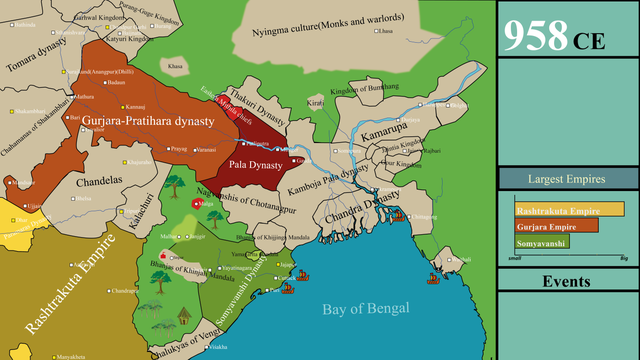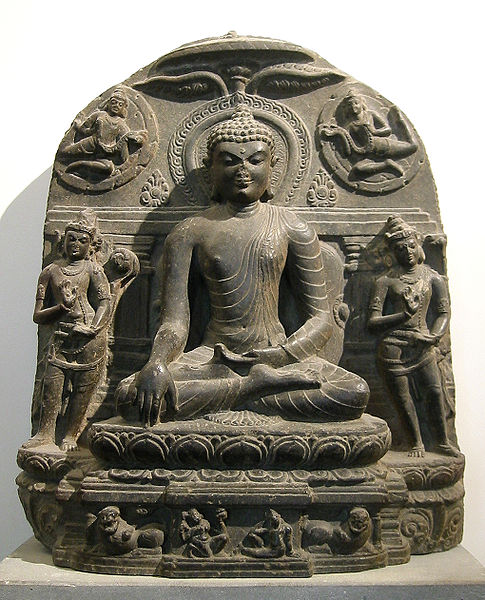KAMBOJ
PAL DYNASTY

Map
of the Kamboj-Pal dynasty in the Middle of the 10th century
The
Kamboj-Pal dynasty ruled parts of Bengal in the 10th to 11th centuries
CE, after invading the Pals during the reign of GoPal II. The last
Kamboj ruler of the Kamboj-Pal Dynasty Dharm Pal was defeated by
the south Indian Emperor Rajendra Chola I of the Chola dynasty in
the 11th century.
Origins
:
During the last centuries BCE, many clans of the Kambojs entered
India in alliance with the Sakas, Pahlavas, Yavans and spread into
Sindhu, Saurashtra, Malwa, Rajasthan, Punjab and Shursen. An offshoot
of the Meerut Kambojs moved eastwards and entered the Pal domains
and in the 10th century, conquering north-west Bengal. Kamboj tribes
were employed by the Pals following Dev Pal's conquests due to the
lack of native cavalry in Bengal.
Ancient
sources on Kamboj Rule in Bengal :
There are several ancient inscriptions which attest Kamboj rule
in Bengal. The most important sources are :
Dinajpore
Pillar Inscription :
The Dinajpur Pillar Inscription records to a Kamboj king called
the Kambojnvaya Gaudapati (i.e. lord of Gaud).. The Pillar Inscription
was originally established in a Shiv temple that was built by the
king but removed to Bangar, about 40 miles east of Gaud, during
the period of Muslim rule. During the 18th century, the Pillar was
further moved to Dinajpore by Maharaja Ram Nath and as a result,
the inscription came to be known as Dinajpore Pillar Inscription.
The Dinajpore Pillar Inscription dates to the second half of the
10th century.
Irda
Copper Plate (Tamrapatra) :
The Irda Copper plate (Irda Tamarapatra) is another source on the
Kamboj-Pal dynasty and was discovered in 1931. It is written in
Sanskrit and has 49 lines of text in ancient Bengali script. The
Vansh or the tribal identity of the rulers mentioned in the Irda
Copper Plate is specifically stated to be Kamboj-Vansh-Tilak (i.e.
Ornament of the Kamboj family or Glory of the Kamboj tribe). [citation
needed] Like the Dinajpore Pillar Inscriptions, the Irda Copper
plate is also thought to belong to the second half of tenth century
(Dr N. G. Majumdar, Dr R. C. Majumdar). Hence the academic community
believes that the Kambojnvaya Gaudapati of Dinajpore Pillar Inscriptions
and the Kambojvamshatilak Paramasaugat Maharajadhiraj parameshvar
paramabhattarak RajyaPal of Kamboj-Pal dynasty of Irda Copper Plate
Inscriptions refers to the same Kamboj family. But whereas the Dinajpur
Pillar inscriptions refer just to one Kamboj ruler with the appellation
of "Kambojnvaya Gaudapati", the Irda Copper plate, mentions
generation after generation of the Kamboj-Pal kings of Bengal i.e.
Rajya Pal, Narayana Pal and Nay Pal etc. The Kamboj-Pal kings of
the Irda Copper plate had ruled north-west Bengal in the tenth or
eleventh century.
Bangar
Grant of Mahi Pal I :

Buddh
and Bodhisattvas, 10th/11th century: Kamboj.vansh.tilak Rajya Pal
of the Irda Copper plate was a Param-saugat (devoted Buddhist),
but other kings of the Kamboj-Pal dynasty were Vedic Hindus
Bangar Charter of Mahi Pal I is the third very important ancient
source of Kamboj rule in Bengal. The charter asserts that Mahi Pal
had re-conquered nearly the whole of north and east Bengal "after
defeating the usurpers who had seized his ancestral kingdom".
The same verse has been repeated in the Aamgaachhi Charter of Vigrah
Pa l -3. But "Who were the usurpers the inscription does not
tell, but other evidences indicate that the rulers belonging to
the Kamboj family were in possession of the north and west Bengal".
Scholars believe that Mahi Pal's Charter alludes to the seizing
of the northern parts of Bengal by Kamboj dynasty from the Go Pal
II or Vigrah Pal II of the Pal dynasty, which the great king Mahi
Pal I claims to have won back by the force of his arms.
Extent
of Kamboj Empire :
No definite information is available on the precise geographical
area of the Kamboj-Pal kingdom of Bengal. According to Irda Copper
plate evidence, the Kamboj-Pal kingdom definitely comprised Varadhman-Bhukti
Mandal (modern Burdman division) and Dandabhukti Mandal within the
Kamboj empire. The Dandabhukti division is believed to have comprised
southern and south-western parts of district Midnapore as well as
the lower parts of river Suvaranrekha in district Balasore. Evidence
from Dinajpore Pillar Inscription attests that the Gaud country
also formed parts of Kamboj-Pal kingdom. But as long as we do not
include northern Ladha (Radha or W. Bengal) in Kamboj-Pal empire,
the region does not constitute one viable political entity. Hence
it appears likely that northern parts of Radha may also formed parts
of Kamboj-Pal kingdom. Dr R. C. Majumdar says that Gaud and Radha
both formed parts of Kamboj-Pal empire. During second half of the
10th century, the Chandel ruler Yashovarman invaded the Pal kingdom.
Vakpati, a courtier-poet, claims that he conquered Gaud and Mithila.
It is also stated that Chandel chief Dhang of Jejabhukti, the successor
of Yashovarman, had invaded Radha towards the end of the 10th century.
As a consequence, the Kamboj power in the north Bengal received
a severe jolt. This political scenario enabled the Pal king Mahi
Pal I to re-conquer Gaud from the Kambojs. The last king of the
Kambojs was Dharam Pal who continued to rule Dandabhukti in the
first quarter of the 11th century. The Kamboj ruler Dharam Pal of
Dandabhukti was defeated by the south Indian Emperor Rajendra Chola
I who invaded Bengal and Bihar in the 11th century. The Capital
of the Kamboj Pal kingdom is stated to be Pryangu which has not
been identified yet, though some scholars tend to identify the same
with an old village known as Pingvani located in Garvet Than.
Known
Kamboj kings of Bengal :
We know the names of three Kamboj rulers of the Kamboj Pal family
for sure viz. Rajya Pal, Narayan Pal and Nay Pal. The Charter (Copper
Plate Inscription) was issued by Kamboj king Nay Pal wherein he
and his father are given the imperial titles like Parameshevar,
Paramabhattacharya and Maharajadhiraj. The Copper Plate Inscription
also attests that the founder of the Kamboj Pal dynasty was king
Rajya Pal. He has been referred to as Kambojvamshatilak Paramsaugat
Maharajadhiraj parameshvar paramabhatt Arak-Rajya Pal. This proves
that this line of kings belonged to the Kamboj lineage. The second
king is Narayan Pal who was son of Rajay Pal. Narayan Pal was succeeded
by his younger brother Nay Pal, the author of the Irda Copper plate.
Dr R. C. Majumdar states that the expression Kunjarghatavarshan
of the Dinajpore Pillar Inscription indicates that Kunjarghatavarshan
was personal name of Kambojnvaya Gaudapati of the Dinajpore Pillar
Inscription. If this is so, then this Kambojnvaya Gaudapati is the
fourth known Kamboj king of Kamboj dynasty of Bengal. Some scholars
however believe that the Kambojnvaya Gaudapati of the Dinajpore
Pillar Inscriptions is same as Kambojvamshatilaka Rajya Pal of the
Irda Copper plate. This does not seem to be true since Rajya Pal
of the Irda Copper plate is described as devotee of Buddh (Param-saugat)
whereas Kambojnvaya Gaudapati of Dinajpore Pillar Inscriptions claims
in his own inscription to be a Siva devotee. It may however be possible
that Kambojnvaya Gaudapati is same as Kamboj king Naya Pal of the
Irda Copper plate since king Naya Pal also claims to be a Saivite
(Siva devotee) in the Irda Copper plate. The last known ruler of
the Kamboj Pal dynasty is stated to be king Dharam Pal who ruled
in Dandabhukti in first quarter of the 11th century.
Religion
of Kamboj rulers of Bengal :
The Kambojnvaya Gaudapati of Dinajpore Pillar Inscriptions is stated
to be a builder of Shiv temple and therefore was devotee of Shiv.
He is said to be a great bestower of the charities. Kambojvamsatilak
Rajaya Pal, the first king of the Irda Copper plate is referred
to as Param-saugat (devotee of Buddh). The third ruler Narayan Pal
Kamboj is stated to be a devotee of god Vishnu. King Naya Pal Kamboj,
the author of Irda Copper plate is known to have practised Shiv
cult. There is no information on the Kamboj ruler Dharam Pal, but
it appears likely that he may have also been a Vedic follower i.e.
either Saivite or a Vishnu devotee. The Irda Copper plate has references
to Hindu gods, high rising temple buildings as well as to the sacred
smokes rising from the Yagya fires into the skies. This again alludes
to the Hinduism of the Pal Kambojs. Irda Copper plate also makes
special references to the Purohits, Kritivajyas, Dharmagyas and
other holy officials. Thus we find that the Kamboj kings of Bengal
were mostly Vedic Hindus, of course, with the exception of king
Rajya Pal. Mention is made of grants of lands and villages to the
Purohits in the Burdwan district of east Bengal. According to Prof
R. C. Majumdar: "More significant, however, is the inclusion
of Purohits in the land grants of the Kamboj, Varman and Sen kings
of Bengal. It indicates the great importance was attached to religious
and social aspects of administration during rules of these dynasties
which were all followers of orthodox Hinduism." Dr B. N. Sen
says that the Buddhism which had followers in the early Pal and
Candra rulers was probably on the decline in Bengal during the 10th
century. On the other hand, the Vedic religion was on the rise.
Since the Kamboj Pal kings of Bengal were mostly Vedic Hindus, hence
they must have got full support from their subject which must have
helped them raise a powerful empire in Bengal.
Kambojs
in caste system of Bengal :
In the ancient caste classification in Bengal, there are references
to people who came as invaders from northwest or accompanied the
invaders. These people have been described as Malechs in the brahmanical
Caste System in Bengal. Ancient Sanskrit and Pali texts and inscriptions
profusely attest the Kambojs as a Malech tribe of Uttarapath or
Udichya division belonging to Indo-Iranian or Scytho-Aryan and not
to the Mongolian stock.
The
north-westerners including the Kambojs, Sakas, Huns, Yavans, Abhiras,
Khass, Sabars, Turushks, Suhms etc. have all been labelled as outsiders,
foreigners or Malechs within the Bengali society and therefore were
left outside the Caste Classification of ancient Bengal. Compare
also: Part-II: VI. Ancient peoples of Bengal.
Evidence
on later Kamboj rulers in Bengal :
There is a literary evidence which attests one Kamboj king known
as Jagan Nath ruling in Bengal as late as the 16th century. King
Jagan Nath is stated to have patronised a Brahman scholar Sur Mishra
who had composed Jagannathaprakash, a Smriti Granth in honour of
this Kamboj king:
Adesh.Kambojkul.vatansah
Shri Jagan Nath iti parsidhah
Akaryad dharmanibandhmaytam dhradhipaiapayairkablai nreshe
This shows that the Kamboj rule in some parts of Bengal must have
continued, as late as the 16th century.
Source
:
https://en.wikipedia.org/
wiki/Kamboja_Pala_dynasty


